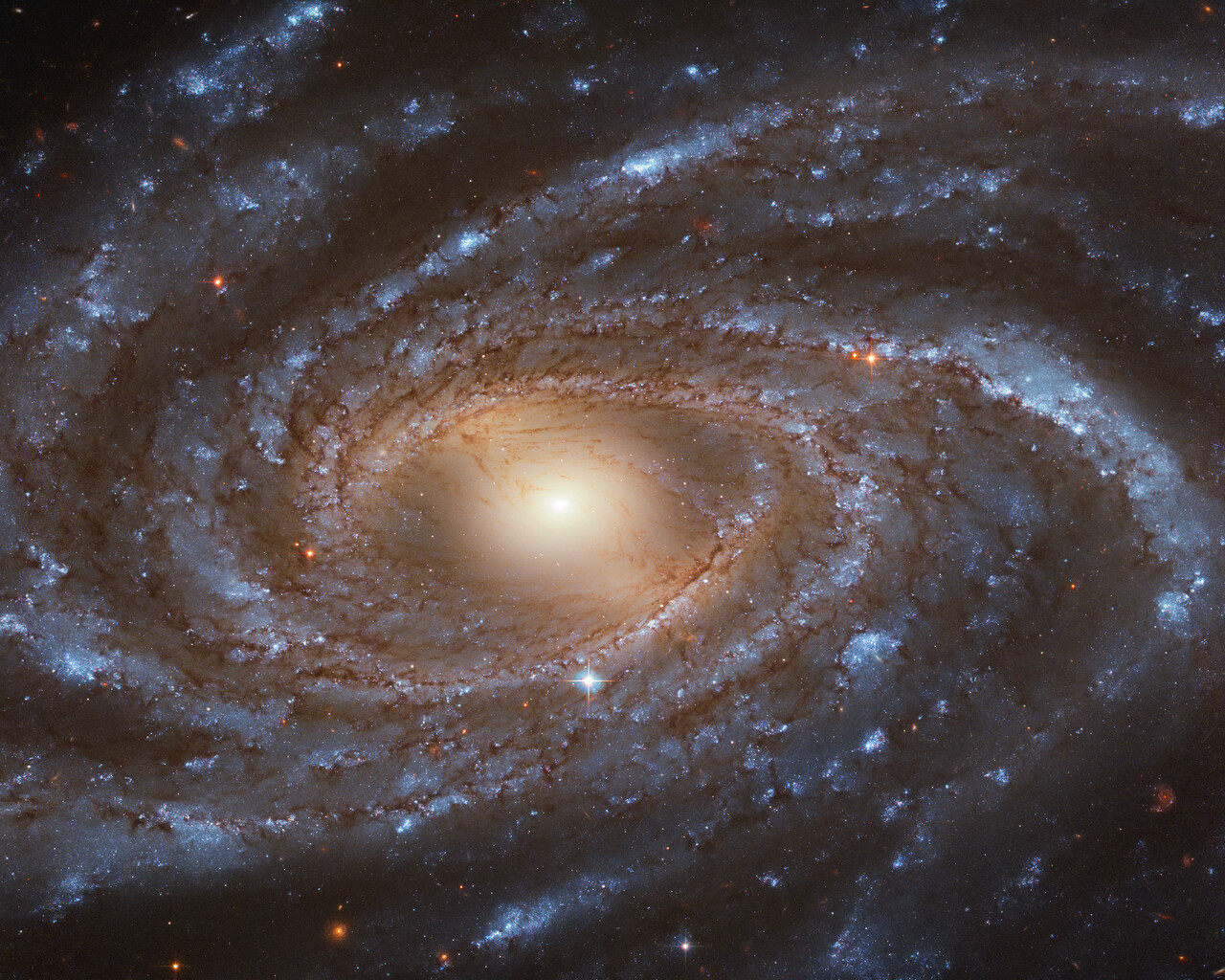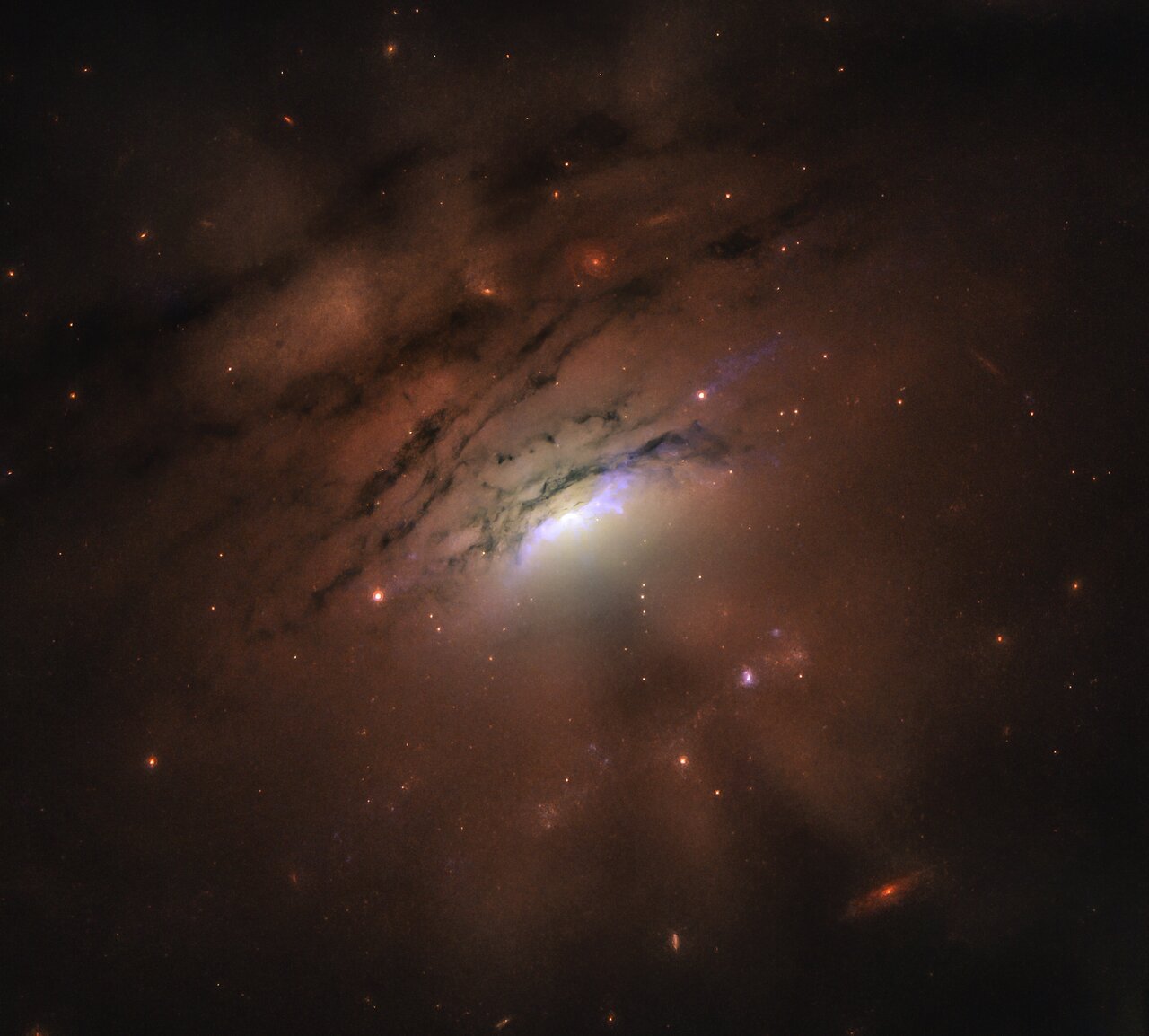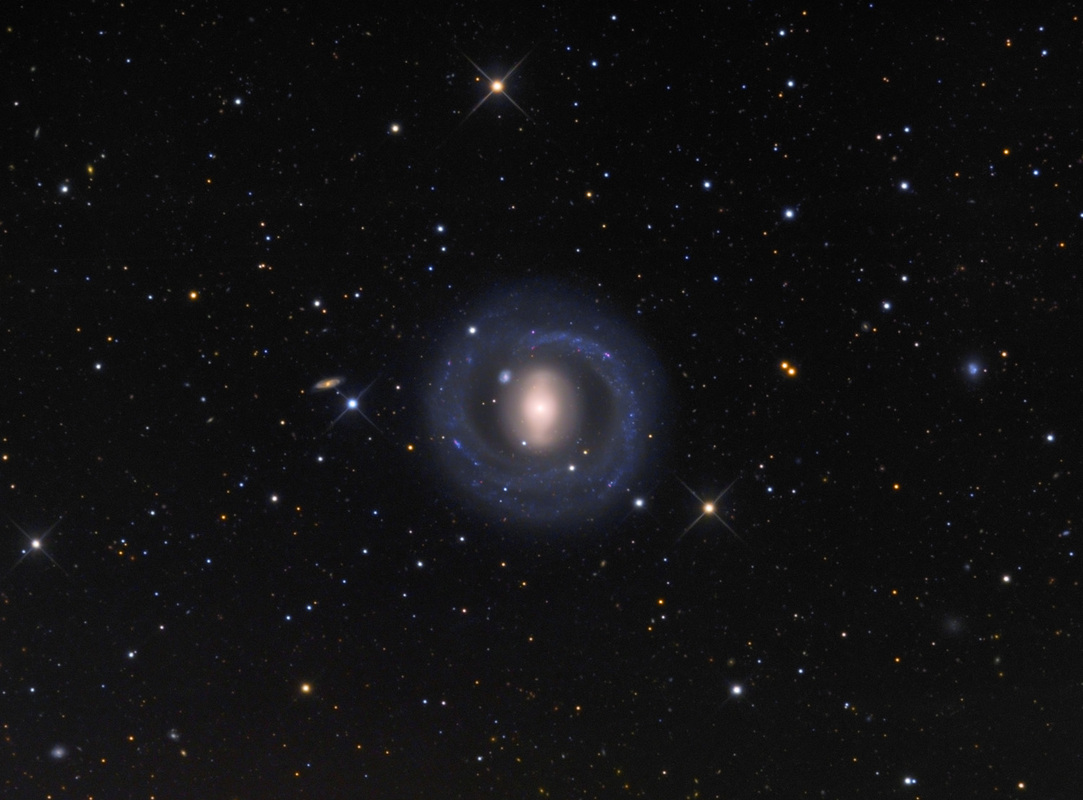Blog
NGC 2336 is the quintessential galaxy — big, beautiful and blue — and it is captured here by the NASA/ESA Hubble Space Telescope. The barred spiral galaxy stretches an immense 200 000 light-years across and is located approximately 100 million light years away in the northern constellation of Camelopardalis (The Giraffe). Its spiral arms are glittered with young stars, visible in their bright blue light. In contrast, the redder central part of the galaxy is dominated by older stars. NGC 2336 was discovered in 1876 by German astronomer Wilhelm Tempel, using a 28-centimetre telescope. This Hubble image is so much better than the view Tempel would have had — Hubble’s main mirror is 2.4 metres across, nearly ten times the size of the telescope Tempel used. In 1987, NGC 2336 experienced a Type-Ia supernova, the only observed supernova in the galaxy since its discovery 111 years earlier.

Winston Rodney OD (born 1 March 1945), better known by the stage name Burning Spear, is a Jamaican roots reggae singer-songwriter, vocalist and musician. Burning Spear is a Rastafarian and one of the most influential and long-standing roots artists to emerge from the 1970s.
Winston Rodney was born in Saint Ann’s Bay, Saint Ann, Jamaica. As a young man he listened to the R&B, soul and jazz music transmitted by the US radio stations whose broadcasts reached Jamaica. Curtis Mayfield is cited by Rodney as a major US musical influence along with James Brown. Rodney was deeply influenced as a young man by the views of the political activist Marcus Garvey, especially with regard to the exploration of the themes of Pan-Africanism and self-determination. In 1969, Bob Marley, who was also from Saint Ann, advised Rodney to approach Coxsone Dodd‘s Studio One label after Rodney sought his advice during a casual conversation.
Burning Spear was originally Rodney’s group, named after a military award given by Jomo Kenyatta, the first President of an independent Kenya, and included bass singer Rupert Willington. The duo auditioned for Dodd in 1969 which led to the release of their debut single “Door Peep” (the session also included Cedric Brooks on saxophone). They were then joined by tenor Delroy Hinds. The trio recorded several more singles for Dodd, and two albums, before they moved on to work with Jack Ruby in 1975. Their first recording with Ruby, “Marcus Garvey”, was intended as an exclusive track for Ruby’s Ocho Rios–based Hi-Power sound system, but was released as a single, giving them an immediate hit, and was followed by “Slavery Days”. These recordings featured the backing band The Black Disciples, which included Earl “Chinna” Smith, Valentine Chin, Robbie Shakespeare and Leroy Wallace. The group worked with Ruby on their third album, Marcus Garvey (1975), which was immediately successful and led to a deal with Island Records to give the album a wider release.
more...Ralph Towner (born March 1, 1940, Chehalis, Washington) is an American multi-instrumentalist, composer, arranger and bandleader. He plays the twelve-string guitar, classical guitar, piano, synthesizer, percussion and trumpet. Towner was born into a musical family in Chehalis, Washington. His mother was a piano teacher and his father a trumpet player. Towner learned to improvise on the piano at the age of three. He began his career as a conservatory-trained classical pianist, attending the University of Oregon from 1958-1963, where he also studied composition with Homer Keller. He studied classical guitar at the Vienna Academy of Music with Karl Scheit from 1963-64 and 1967-68.
He joined world music pioneer Paul Winter‘s “Consort” ensemble in the late 1960s. He first played jazz in New York City in the late 1960s as a pianist and was strongly influenced by the renowned jazz pianist Bill Evans. He began improvising on classical and 12-string guitars in the late 1960s/early 1970s and formed alliances with musicians who had worked with Evans, including flautist Jeremy Steig, bassists Eddie Gómez, Marc Johnson, Gary Peacock, and drummer Jack DeJohnette.
Along with bandmates Paul McCandless, Glen Moore, and Collin Walcott, Towner left the Winter Consort in 1970 to form the group Oregon, which over the course of the 1970s issued a number of highly influential records mixing folk music, Indian classical forms, and avant-garde jazz-influenced free improvisation. At the same time, Towner began a longstanding relationship with the influential ECM record label, which has released virtually all of his non-Oregon recordings since his 1973 debut as a leader Trios / Solos.
more...Benny Powell (March 1, 1930 – June 26, 2010) was an American jazz trombonist. He played both standard (tenor) trombone and bass trombone.
Born Benjamin Gordon Powell Jr in New Orleans, Louisiana, he first played professionally at the age of 14, and at 18 began playing with Lionel Hampton. In 1951 he left Hampton’s band and began playing with Count Basie, in whose orchestra he would remain until 1963. Powell takes the trombone solo in the bridge of Basie’s 1955 recording of “April in Paris“.
After leaving Basie, he freelanced in New York City. From 1966 to 1970 he was a member of the Thad Jones–Mel Lewis Jazz Orchestra, playing on Monday nights at the Village Vanguard. Among other engagements, he played in the house band of the Merv Griffin Show, and when the show moved to Los Angeles, California, in 1970 Powell also relocated there. He did extensive work as a session musician, including with Abdullah Ibrahim, John Carter, and Randy Weston. Later in his career Powell worked as an educator, including as part of the Jazzmobile project. Having moved back to New York in the 1980s, he began teaching at the New School for Jazz and Contemporary Music in 1994.
He died in a Manhattan hospital at the age of 80, following back surgery.
more...Harry Belafonte (born Harold George Bellanfanti Jr.; March 1, 1927 Harlem, NY) is an American singer, songwriter, activist, and actor. One of the most successful Jamaican-American pop stars in history, he was dubbed the “King of Calypso” for popularizing the Trinidadian Caribbean musical style with an international audience in the 1950s. His breakthrough album Calypso (1956) was the first million-selling LP by a single artist. Belafonte is known for his recording of “The Banana Boat Song“, with its signature lyric “Day-O”. He has recorded and performed in many genres, including blues, folk, gospel, show tunes, and American standards. He has also starred in several films, including Otto Preminger‘s hit musical Carmen Jones (1954), Island in the Sun (1957), and Robert Wise‘s Odds Against Tomorrow (1959).
Belafonte was an early supporter of the Civil Rights Movement in the 1950s and 1960s and was a confidant of Martin Luther King Jr.. Throughout his career, he has been an advocate for political and humanitarian causes, such as the Anti-Apartheid Movement and USA for Africa. Since 1987, he has been a UNICEF Goodwill Ambassador. He was a vocal critic of the policies of the George W. Bush presidential administrations. Belafonte acts as the American Civil Liberties Union celebrity ambassador for juvenile justice issues.
Belafonte has won three Grammy Awards (including a Grammy Lifetime Achievement Award), an Emmy Award, and a Tony Award. In 1989, he received the Kennedy Center Honors. He was awarded the National Medal of Arts in 1994. In 2014, he received the Jean Hersholt Humanitarian Award at the Academy’s 6th Annual Governors Awards.
more...Charles R. Rice (March 1, 1920 – April 22, 2018), better known as Charlie Rice, was an American jazz drummer. Having played with Jimmy Oliver, Rice led the first house band at Philadelphia’s Club 421, with a lineup including Vance Wilson, Bob Bushnell, Red Garland and Johnny Hughes.
After playing with Eddie Vinson‘s and Jimmy Heath‘s big bands (with John Coltrane in both lineups) in 1951 he went with Oscar Pettiford, Rudy Williams, Clifton Best, J.J. Johnson and Howard McGhee on a USO tour to the South Pacific, as part of a unit known as the “Swingin’ Jamboree”. The concerts were recorded and released the following year as Howard McGhee and his Korean All Stars, Jazz At the Battlefront Volume 1. Back in Philadelphia, he led the Charlie Rice All-Stars. As well as playing with Sonny Stitt, Eddie “Lockjaw” Davis (again with John Coltrane), and Leo Parker, in 1964 and 1965 he toured and recorded with Chet Baker. As of October 2011, Rice was still performing. He died in April 2018 at the age of 98. He was buried at Harleigh Cemetery, Camden.
more...Some of the most stunning views of our sky occur at sunset, when sunlight pierces the clouds, creating a mixture of bright and dark rays formed by the clouds’ shadows and the beams of light scattered by the atmosphere. Astronomers studying the nearby galaxy IC 5063 are tantalized by a similar effect in this new image from the NASA/ESA Hubble Space Telescope. In this case, a collection of narrow bright rays and dark shadows is seen beaming out of the blazingly bright center of the active galaxy, shooting across at least 36,000 light-years. Astronomers have traced the rays back to the galaxy’s core, the location of an active supermassive black hole. The black hole is feeding on infalling material, producing a powerful gusher of light from superheated gas near it. Although the researchers have developed several plausible theories for the lightshow, the most intriguing idea suggests that the shadows are being cast into space by an inner tube-shaped ring, or torus, of dusty material surrounding the black hole. IC 5063 resides 156 million light-years from Earth.

Lewis Brian Hopkin Jones (28 February 1942 – 3 July 1969) was an English musician and composer, best known as the founder and original leader of the Rolling Stones. Initially a slide guitarist, Jones went on to play a wide variety of instruments on Rolling Stones recordings and in concerts, including rhythm guitar, lead guitar, sitar, dulcimer, various keyboard instruments such as piano and mellotron, marimba, wind instruments such as harmonica, recorder, saxophone, as well as drums, vocals and numerous others.
After he founded the Rolling Stones as a British blues outfit in 1962, and gave the band its name, Jones’ fellow band members Keith Richards and Mick Jagger began to take over the band’s musical direction, especially after they became a successful songwriting team. Jones and fellow guitarist Richards also developed a unique style of guitar play that Richards refers to as the “ancient art of weaving” where both players would play rhythm and lead parts together. Richards continued the style with later guitarists, and the sound became a Rolling Stones trademark. Jones, however, did not get along with the band’s manager, Andrew Loog Oldham, who pushed the band into a musical direction at odds with Jones’ blues background.
When Jones developed alcohol and drug problems, his performance in the studio became increasingly unreliable, leading to a diminished role within the band he had founded. In June 1969, the Rolling Stones dismissed Jones; guitarist Mick Taylor took his place in the group. Jones died less than a month later, drowning in the swimming pool at his home at the age of 27. Jones’s death was referenced in songs by many other pop-bands, and was the subject of poems by Pete Townshend and Jim Morrison. Referring to Jones, the Rolling Stones’ Bill Wyman lamented the waste of a great innovator. In 1989, the Rolling Stones, including Jones, were inducted into the Rock and Roll Hall of Fame.
more...John Aloysius Fahey (/ˈfeɪhi/ FAY-hee; February 28, 1939 – February 22, 2001) was an American fingerstyle guitarist and composer who played the steel-string acoustic guitar as a solo instrument. His style has been enormously influential and has been described as the foundation of the genre of American primitive guitar, a term borrowed from painting and referring mainly to the self-taught nature of the music and its minimalist style. Fahey borrowed from the folk and blues traditions in American roots music, having compiled many forgotten early recordings in these genres. He would later incorporate 20th-century classical, Portuguese, Brazilian, and Indian influences into his work.
Fahey spent many of his later years in poverty and poor health, but enjoyed a minor career resurgence in the late 1990s, with a turn towards the avant-garde. He also created a series of abstract paintings in his final years. Fahey died in 2001 from complications from heart surgery. In 2003, he was ranked 35th on Rolling Stone magazine’s “100 Greatest Guitarists of All Time” list.
Fahey was born into a musical household in Washington, D.C. in 1939. Both his father, Aloysius John Fahey, and his mother, Jane (née Cooper), played the piano. In 1945, the family moved to the Washington suburb of Takoma Park, Maryland, where his father lived until his death in 1994. On weekends, the family attended performances of the top country and bluegrass acts of the day, but it was hearing Bill Monroe‘s version of Jimmie Rodgers‘ “Blue Yodel No. 7” on the radio that ignited the young Fahey’s passion for music.
more...William Correa (February 28, 1934 – September 15, 1983), better known by his stage name Willie Bobo, was an American Latin jazz percussionistof Puerto Rican descent. Correa grew up in Spanish Harlem, New York City.
Correa became a noted timbales performer in Latin jazz, specifically Afro-Cuban jazz, in the 1960s and 1970s. He met Mongo Santamaría shortly after his arrival in New York and studied with him while acting as his translator, and later at the age of 19 joined Tito Puente for four years.
The nickname Bobo is said to have been originated by the jazz pianist Mary Lou Williams in the early 1950s.
Correa joined George Shearing‘s band on the album The Shearing Spell. After leaving Shearing, Cal Tjader asked Bobo and Santamaría to become part of the Cal Tjader Modern Mambo Quintet, who released several albums as the mambo craze reached fever pitch in the late 1950s. Reuniting with his mentor Santamaría in 1960, the pair released the album Sabroso! for the Fantasy label. Bobo later formed his own group, releasing Do That Thing/Guajira with Tico and Bobo’s Beat and Let’s Go Bobo for Roulette, without achieving huge penetration.
After the success of Tjader’s Soul Sauce, in which he was heavily involved, Correa formed a new band with the backing of Verve Records, releasing Spanish Grease, the title track being perhaps his most well known tune. Highly successful at this attempt, Correa released a further six albums with Verve.
more...Svend Asmussen (28 February 1916 – 7 February 2017) was a Danish jazz violinist, known as “The Fiddling Viking”.[1] A Swing style virtuoso, he played and recorded with many of the greats of Jazz, including Duke Ellington, Benny Goodman and Stephane Grappelli. He played publicly until 2010 when he had a blood clot, his career having spanned eight decades. Asmussen was born in Copenhagen, Denmark, raised in a musical family, and started taking violin lessons at the age of 7. At age 16 he first heard recordings by jazz violin great Joe Venuti and began to emulate his style. He started working professionally as a violinist, vibraphonist, and singer at age 17, leaving his formal training behind for good. Early in his career he worked in Denmark and on cruise ships with artists such as Josephine Baker and Fats Waller. Asmussen later was greatly influenced by Stuff Smith, whom he met in Denmark. Asmussen played with Valdemar Eiberg and Kjeld Bonfils during World War II, during which time jazz had moved to the underground and served as a form of political protest.
more...https://www.youtube.com/watch?v=U0qVp5dbz2E
more...NGC 5701 is a lenticular SB0-a-type galaxy in the constellation Virgo , approximately 68 million light years from the Milky Way. The galaxy was discovered on April 29, 1786 by the German-British astronomer William Herschel .
More Posts
- Daily Roots with Playing for Change
- Diego LaBriola Birthday
- The Cosmos with M63
- John Coltrane Day
- Ray Charles Day
- World Music with Simo Lagnawi
- Daily Roots with Playing for Change
- The Cosmos with Doradus 30
- Bobby Radcliff Day
- Fletcher Smith Day
- World Music with Etran Finatawa
- Daily Roots with Melissa
- The Cosmos with NGC 55
- Leonard Cohen Day
- Chico Hamilton Day
- Tommy Potter Day
- World Musician Flamenco Fridays with Diego del Morao
- Daily Roots with Marla Brown
- Red Mitchell Day
- The Cosmos with NGC 6726, 6727, and IC 4812